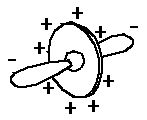Plato's Cave: The Local Field
The Local Field
Each unit in the three-dimensional matrix can be given a local field
of influence, positive (or excitatory) in one plane, and negative
(inhibitory) outside of that plane, as shown below.

The field must be free to orient itself to the direction of maximum
consistency with its local environment. One way to achieve this with
"conventional" neural receptive fields is to have at every spatial
location, separate cells for each orientation, each with the
appropriately oriented spatial receptive field, with a mutually
inhibitory competitive interaction. A less expensive method would be
to implement the fields by way of a three-dimensional or spherical
harmonic interaction, which would emerge naturally at the orientation
of best fit.
Whatever the implementation, there is no question that this
functionality is achievable by defining the proper dynamic
architecture.
Return to argument
Return to Steve Lehar

